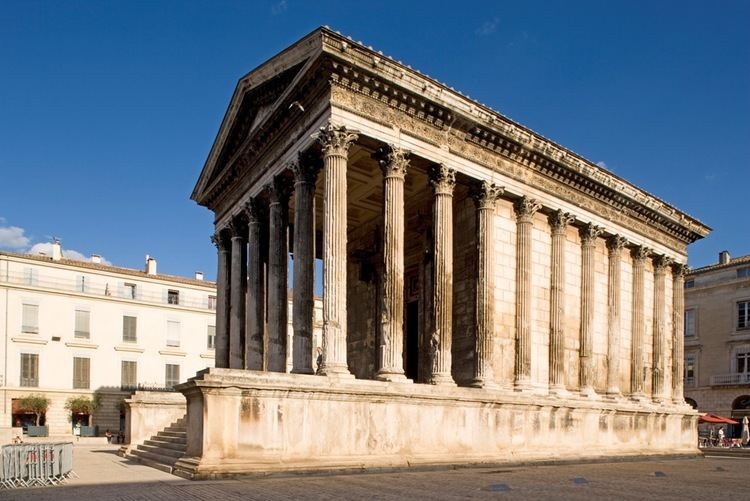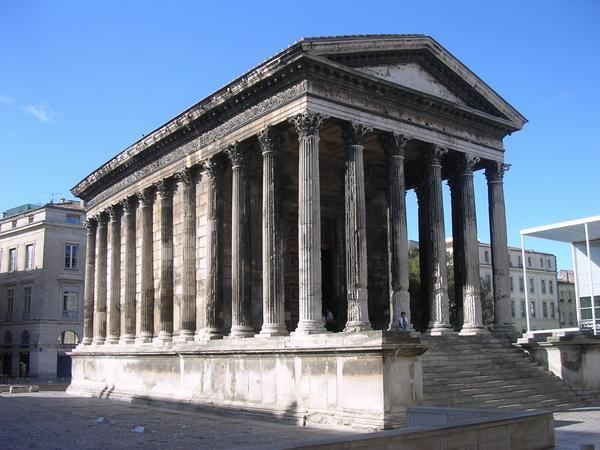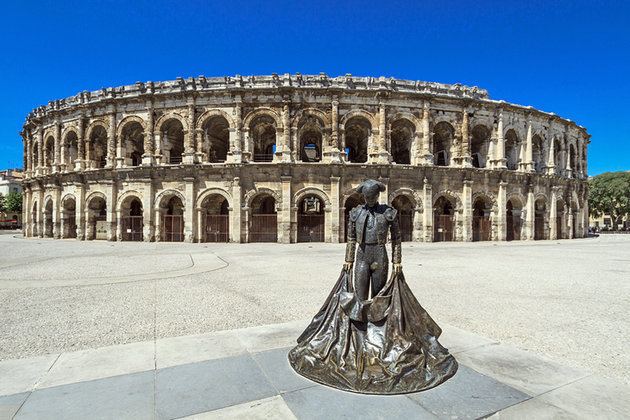Country France | Population 140,267 (2008) Area 140,267 Mayor | |
 | ||
Points of interest Arena of Nimes, Maison Carree, Carre dArt, Pont du Gard, Nimes Cathedral | ||
N mes france bullfighting french style
Nîmes (/niːm/; [nim]; Provençal Occitan: Nimes [ˈnimes]) is a city in the Occitanie region of southern France. It is the capital of the Gard department.
Contents
- N mes france bullfighting french style
- Map of Nmes
- 360 roman temple la maison carr e n mes france
- Climate
- History
- Prehistory
- 40002000 BC
- 1800600 BC
- 60049 BC
- Roman period
- 4th13th centuries
- Period of invasions
- 17th century to the French Revolution
- From the French Revolution to the present
- Sights
- Economy
- Culture
- Transportation
- Sport
- Mayors
- Twin townsSister cities
- References
Map of Nîmes
Nîmes is located between the Mediterranean Sea and the Cévennes mountains. The estimated population of Nîmes is 146,709 (2012).

Nîmes has a rich history, dating back to the Roman Empire when the city was home to 50,000–60,000 people. Several famous monuments are in Nîmes, such as the Nîmes Arena and the Maison Carrée. Because of this, Nîmes is often referred to as the French Rome.
360 roman temple la maison carr e n mes france
Climate

Nîmes has a mediterranean climate that is one of the warmest in France. Its slightly inland, southerly location results in hot air over the city during summer months, whereas winters are cool to mild but not cold.
History
The city derives its name from that of a spring in the Roman village. The contemporary coat of arms of the city of Nîmes includes a crocodile chained to a palm tree with the inscription COL NEM, for Colonia Nemausus, meaning the "colony" or "settlement" of Nemausus, the local Celtic god of the Volcae Arecomici. Veterans of the Roman legions who had served Julius Caesar in his Nile campaigns, at the end of fifteen years of soldiering, were given plots of land to cultivate on the plain of Nîmes.
The city was located on the Via Domitia, a Roman road constructed in 118 BC which connected Italy with Spain.
Its name appears in inscriptions in Gaulish as dede matrebo Namausikabo = "he has given to the mothers of Nîmes" and "toutios Namausatis" = "citizen of Nîmes".
Prehistory
The site on which the built-up area of Nîmes has become established in the course of centuries is part of the edge of the alluvial plain of the Vistrenque River which butts up against low hills: to the northeast, Mont Duplan; to the southwest, Montaury; to the west, Mt. Cavalier and the knoll of Canteduc.
4000–2000 BC
The Neolithic site of Serre Paradis reveals the presence of semi-nomadic cultivators in the period 4000 to 3500 BC on the future site of Nîmes. The population of the site increased during the thousand-year period of the Bronze Age. The menhir of Courbessac (or La Poudrière) stands in a field, near the airstrip. This limestone monolith of over two metres in height dates to about 2500 BC, and must be considered the oldest monument of Nîmes.
1800–600 BC
The Bronze Age has left traces of villages that were made out of huts and branches
600–49 BC
The Warrior of Grezan is considered to be the most ancient indigenous sculpture in southern Gaul. The hill named Mt. Cavalier was the site of the early oppidum, which gave birth to the city. During the third and 2nd centuries BC a surrounding wall was built, closed at the summit by a dry-stone tower, which was later incorporated into the masonry of the Tour Magne. The Wars of Gaul and the fall of Marseille (49 BC) allowed Nîmes to regain its autonomy under Rome.
Roman period
Nîmes became a Roman colony sometime before 28 BC, as witnessed by the earliest coins, which bear the abbreviation NEM. COL, "Colony of Nemausus". Some years later a sanctuary and other constructions connected with the fountain were raised on the site. Nîmes was already under Roman influence, though it was Augustus who made the city the capital of Narbonne province, and gave it all its glory. It was also known as the birthplace of the family of Roman Emperor Antoninus Pius.
The city had an estimated population of 60,000 in the time of Augustus. Augustus gave the town a ring of ramparts six kilometres (3.7 miles) long, reinforced by fourteen towers; two gates remain today: the Porta Augusta and the Porte de France. An aqueduct was built to bring water from the hills to the north. Where this crossed the River Gard between Uzes and Remoulins, the spectacular Pont du Gard was built. This is 20 kilometres (12 miles) north east of the city. Also, the Maison Carrée is one of the best preserved temples to be found anywhere in the territory of the former Roman Empire; it later inspired the design of the Virginia State Capitol at Richmond. Nothing remains of some other monuments, the existence of which is known from inscriptions or architectural fragments found in the course of excavations. It is known that the town had a civil basilica, a curia, a gymnasium and perhaps a circus. The amphitheatre dates from the end of the 2nd century AD and was one of the largest amphitheatres in the Empire.
Emperor Constantine endowed the city with baths. It became the seat of the Diocesan Vicar, the chief administrative officer of southern Gaul.
The town was prosperous until the end of the 3rd century – during the 4th and 5th centuries, the nearby town of Arles enjoyed more prosperity. In the early 5th century the Praetorian Prefecture was moved from Trier in northeast Gaul to Arles. The Visigoths finally captured the city from the Romans in 473 AD.
4th–13th centuries
After the Roman period, in the days of invasion and decadence, the Christian Church, already established in Gaul since the 1st century AD, appeared be the last refuge of classical civilization – it was remarkably organized and directed by a series of Gallo-Roman aristocrats. However, when the Visigoths were accepted in the Roman Empire, Nîmes was included in their territory (472), even after the Frankish victory at the Battle of Vouillé (507). The urban landscape went through transformation with the Goths, but much of the heritage of the Roman era remained largely intact.
By 725, the Muslim Umayyads had conquered the whole Visigothic territory of Septimania including Nîmes. In 736-737, Charles Martel and his brother led an expedition to Septimania and Provence, and largely destroyed the city (in the hands of Umayyads allied with the local Gallo-Roman and Gothic nobility), including the amphitheatre, thereafter heading back north. The Muslim government came to an end in 752, when Pepin the Short captured the city. In 754, an uprising took place against the Carolingian king, but was put down and count Radulf, a Frank, appointed as master of the city. After the war events, Nîmes was now only a shadow of the opulent Roman city it once had been. The local authorities installed themselves in remains of the amphitheatre.
Carolingian rule brought relative peace, but feudal times in the 12th century brought local troubles, which lasted until the days of St. Louis. During that period Nîmes was jointly administered by a lay power resident in the old amphitheatre, where lived the Viguier and the Knights of the Arena, and the religious power based in the Bishop's palace complex, around the cathedral, its chapter and the Bishop's house; meanwhile the city was represented by four Consuls, who sat in the Maison Carrée.
Despite incessant feudal squabbling, Nîmes saw some progress both in commerce and industry as well as in stock-breeding and associated activities.
After the last effort by Raymond VII of Toulouse, St. Louis managed to establish royal power in the region which became Languedoc. Nîmes thus entered finally into the hands of the King of France.
Period of invasions
During the 14th and 15th centuries the Rhone Valley underwent an uninterrupted series of invasions which ruined the economy and caused famine. Customs were forgotten, religious troubles developed (see French Wars of Religion) and epidemics, all of which affected the city. Nîmes, which was one of the Protestant strongholds, felt the full force of repression and fratricidal confrontations (including the Michelade massacre) which continued until the middle of the 17th century, adding to the misery of periodic outbreaks of plague.
17th century to the French Revolution
In the middle of the 17th century Nîmes experienced a period of prosperity. Population growth caused the town to expand, and slum housing to be replaced. Also to this period dates the reconstruction of Notre-Dame-Saint-Castor, the Bishop's palace and numerous mansions (Hotels). This renaissance strengthened the manufacturing and industrial vocation of the city, the population rising from 21,000 to 50,000 inhabitants.
Also in this period the Fountain gardens, the Quais de la Fontaine, were laid out, the areas surrounding the Maison Carrée and the Amphitheatre were cleared of encroachments, whilst the entire population benefited from the atmosphere of prosperity.
From the French Revolution to the present
Following a European economic crisis that hit Nîmes with full force, the Revolutionary period awoke slumbering demons of political and religious antagonism. The White Terror added to natural calamities and economic recession, produced murder, pillage and arson until 1815. Order was however restored in the course of the century, and Nîmes became the metropolis of Bas-Languedoc, diversifying its industry towards new kinds of activity. At the same time the surrounding countryside adapted to market needs and shared in the general increase of wealth.
During the Second World War, Maquis resistance fighters Jean Robert and Vinicio Faïta were executed at Nîmes on 22 April 1943. The Nîmes marshaling yards were bombed by American bombers in 1944.
The 2º Régiment Etranger d'Infanterie (2ºREI), the main motorised infantry regiment of the French Foreign Legion, is garrisoned in Nîmes since 1984.
Sights
Several important remains of the Roman Empire can still be seen in and around Nîmes:
Later monuments include:
There is modern architecture at Nîmes too: Norman Foster conceived the Carré d'art (1986), a museum of modern art and mediatheque; Jean Nouvel the Nemausus, a post-modern residential ensemble, and Kisho Kurokawa a building in the form of a hemicycle to reflect the Amphitheatre.
Tree-shaded boulevards trace the foundations of its former city walls.
Economy
Nîmes is historically known for its textiles. Denim, the fabric of blue jeans, derives its name from this city (Serge de Nîmes).
Culture
A pioneering mathematics journal, Annales de Gergonne, was published from Nîmes from 1810 to 1822 by Joseph Gergonne.
The asteroid 51 Nemausa was named after Nîmes, where it was discovered in 1858.
Two times per year, Nîmes hosts one of the main French bullfighting events, Feria de Nîmes (festival), and several hundreds of thousands gather in the streets.
In 2005 Rammstein filmed their #1 live Album Völkerball in Nîmes, and are returning in 2017.
Transportation
Nîmes-Alès-Camargue-Cévennes Airport serves the city. The Gare de Nîmes is the central railway station, offering connections to Paris (high-speed rail), Marseille, Montpellier, Narbonne, Toulouse, Perpignan, Figueras in Spain and several regional destinations. The motorway A9 connects Nîmes with Orange, Montpellier, Narbonne, and Perpignan, the A54 with Arles and Salon-de-Provence.
There are plans to construct a high-speed TGV line, Contournement Nîmes – Montpellier linking Nîmes and Montpellier with the LGV Méditerranée.
Sport
Ligue 2 football team Nîmes Olympique is based in Nîmes.
The local rugby team is RC Nîmes.
There is a professional volleyball team located here.
Olympic swimming champion Yannick Agnel was born in Nîmes.
Mayors
Twin towns/Sister cities
Nîmes is twinned with:
